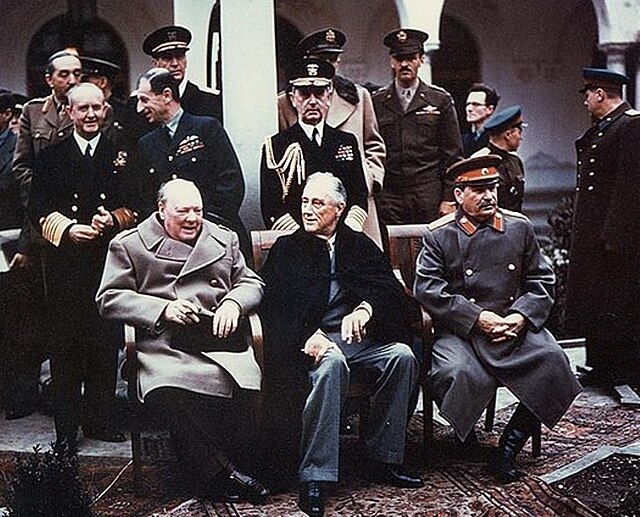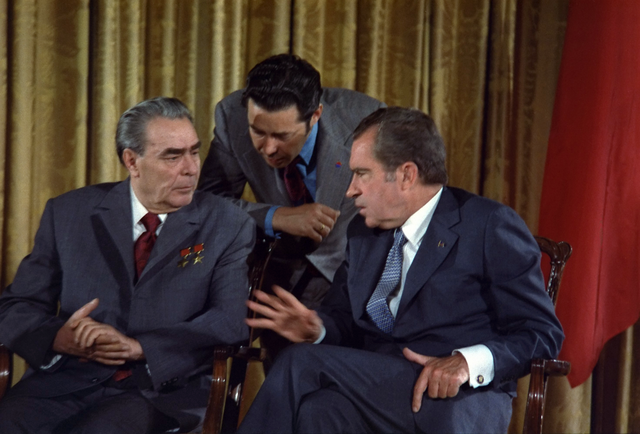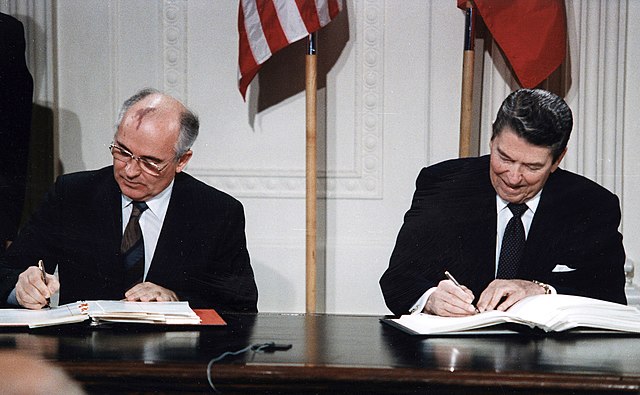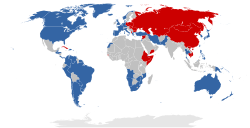Cold War
1947–1991 tension between the Soviet Union and the United States and their respective allies From Wikipedia, the free encyclopedia
Remove ads
The Cold War (1947-1991) was the fighting between the United States and its allies and the Soviet Union and its allies between the end of World War II and the fall of the Soviet Union.[1][2] It is called the "Cold" War because the Americans and the Soviets never actually fought each other directly.
Instead, they influenced or intervened in conflicts known as proxy wars in which powerful countries fight a foreign war but do not send their own troops. Both sides built large militaries with many new weapons and advanced technology. They spied on and threatened each other.
Remove ads
Conflicting countries
Most of the countries on one side were allied by NATO, whose most powerful country was the United States. Most of the countries on the other side were allied by the Warsaw Pact, whose most powerful country was the Soviet Union.[3]
The Western Bloc was the name of the capitalist countries led by the United States. The North Atlantic Treaty Organization (NATO) is an alliance that was created in 1949 and included the United States, the United Kingdom, France, West Germany, Canada, Netherlands, Belgium, Luxembourg, Spain, Portugal, Italy, Norway, Denmark, Greece, and Turkey. Other countries allied with the Western Bloc included Israel, Brazil, South Korea, Kenya (1960-1991), Bangladesh (1964-1968), Pakistan, North Yemen, Malaysia, Saudi Arabia, Philippines, South Africa, Australia and New Zealand.
The Eastern Bloc was the group of communist countries led by the Soviet Union. The Warsaw Pact was an alliance that was created in 1955 and included the Soviet Union, Albania, Bulgaria, Czechoslovakia, East Germany, Hungary, Poland, and Romania. Other countries allied with the Eastern Bloc included Angola (1975–1991), Cuba, Afghanistan, Bolivia, Cambodia (1977–1979), South Yemen, Tunisia, Nepal, Libya (1974–1991), Mongolia, Jamaica, North Korea, Vietnam, China, and Laos (1975–1991).
Remove ads
Background
In February 1917, Tsar Nicholas II of the Russian Empire was overthrown because people were unhappy with their living conditions similar to serfdom and especially the Russian defeat during World War I. The new government in Russia was a democratic socialist government. Unfortunately, it was ineffective, and people were still unhappy. In November 1917, a communist group called the Bolsheviks, led by Vladimir Lenin, overthrew the new government and were supported by groups of workers called soviets. The Bolsheviks created a new communist government, called the Russian Soviet Federation Socialist Republic, also called simply Soviet Russia or the Russian SFSR.
However, not everyone supported the communists. Many countries that had been part of the Russian Empire left, such as Belarus, Estonia, Latvia, and Lithuania. The Russian Civil War began, with the Red Army of communist Russians fighting the White Army of anti-communist Russians. The White Army was not very united or organized. The allies of World War I, such as the United States, the United Kingdom, and France, invaded Russia to support the White Army and stop the Red Army. The Red Army eventually won the war in 1922 and established the Union of Soviet Socialist Republics, also called the Soviet Union, along with the newly-formed Ukrainian, Armenian, Azerbaijan, and Georgian Soviet Socialist Republics.
World War II
The start of the Cold War in 1947 was caused by a belief that all governments would become either communist or capitalist. The Western Allies feared that the Soviet Union would spread communism to the rest of Europe and were very concerned that Soviet agents had found out how to make nuclear weapons after World War II.
Both nations had opposed Nazi Germany although the United States worked with German scientists,[4][5] and the Soviet Union had chosen not to fight Germany by the Molotov-Ribbentrop pact, and the two occupied Poland in 1939. However, Germany turned against the Soviet Union in June 1941 and invaded it during Operation Barbarossa.
Remove ads
After World War II

After World War II, Germany was left in ruins. The victorious Allies occupied it and split it into four parts. In the western half of Germany, one part was given to the United States, one to the United Kingdom, and one to France. The eastern half of Germany was occupied by the Soviets. The city of Berlin was also split among the four countries even though it was entirely within the eastern half.

The Federal Republic of Germany (Bundesrepublik Deutschland or BRD), or West Germany, was recognized by the Western Allies in June 1949 and was a capitalist democracy. West Berlin was considered part of the country. The Soviets named their section of Germany the German Democratic Republic (Deutsche Demokratische Republik or DDR), or East Germany, later in 1949 and established it as a socialist state.
From April 1948 to May 1949, the Soviets blockaded West Berlin to prevent the city from using the West German currency. The United States and its allies supplied the city by airplanes until September 1949 in what became known as the Berlin Airlift. Many East Germans wanted to live in West Germany, which had a greater quality of life and more political freedom. In 1961, the East German government built the Berlin Wall, divided the two halves of the city, and heavily guarded it to prevent more people from escaping to the West. The wall was considered a symbol of the Cold War and the Iron Curtain that divided Europe.
Khrushchev era (1953–1964)

Espionage, also called spying, has been around for a long time and was very important during the Cold War. After its successful nuclear espionage during the Manhattan Project, the Soviets created their spy organs, especially the KGB. The CIA led Americans efforts abroad, and the FBI led counterespionage. The KGB caught foreign spies and fought domestic subversion.
In 1953, the Soviet leader, Joseph Stalin, died, and Nikolai Bulganin and Nikita Khrushchev took his place. Khrushchev later took sole control of the Soviet Union. Khrushchev's Secret Speech marked a period of de-Stalinization, and Khrushchev tried to undo many of Stalin's actions such as the gulags and Stalin's cult of personality.
In the United States, there was a Red Scare, and when the Soviets detonated their own nuclear bomb, there was a big political fallout, and the United States was scared of communists. Famous people in many fields who had been communist sympathizers in the past like Larry Adler lost their positions. Many actors were blacklisted and so were not hired to act in movies, which ruined their careers. U.S. Senator Joseph McCarthy was believed by many when he accused some important Americans of being communists, including government officials with high positions.


The 1950s were the beginning of the Space Race between the United States and the Soviet Union. It began when the Soviets put the first satellite, Sputnik 1, into orbit around Earth and were the first country to send a vehicle into space. The United States responded by starting NASA and soon sent up its own satellites. The Soviets also sent the first man, Yuri Gagarin, into Earth orbit and claimed that proved communism to be a better ideology than capitalism.
In the 1950s, the United States, led by President Dwight Eisenhower, created a policy called "New Look" to cut defense spending and to increase the number of nuclear weapons as a deterrent to prevent the Soviet Union from attacking the West. The Soviets also increased their nuclear force, which resulted in mutual assured destruction.
In the Suez Crisis of 1956, the Cold War's alliances were broken in an important way for the first time, with the Soviet Union and United States supporting one side and Britain and France the other. The Western Allies also decided to let Soviet troops suppress the Hungarian Revolution of 1956.
US Vice-President Richard Nixon engaged in several talks with Khrushchev during the 1950s. One of them was the 1959 "Kitchen Debate" in a model kitchen in Moscow. The debates highlighted the political and economic differences between the Americans and the Soviets. The following year, an American U-2 spy plane crashed in the Soviet Union. Tensions between the two countries increased.
Remove ads
Cuban Missile Crisis (1962)

After the Americans' Bay of Pigs invasion had failed, the Soviet Union attempted to supply Cuba with nuclear missiles. The missiles in Cuba would have allowed the Soviet Union to target almost the entire United States effectively. In response, the United States sent a large number of ships to blockade Cuba to prevent the Soviets from sharing the weapons.
The United States and Soviet Union agreed 13 days later that the Soviet Union would recall their missiles, and the US would recall its own missiles in Turkey and avoid invading Cuba again. It was the highest period of tension during the Cold War and the closest that the world came to a nuclear war, with possible global conflict to follow.
Remove ads
Détente (1962–1981)

After the agreement that ended the Cuban Missile Crisis, relations between both sides eased. Several treaties were signed that were designed to reduce the number of nuclear weapons. In 1964, US President Lyndon Johnson decided to fight North Vietnam, which resulted in a humiliating defeat for the US after South Vietnam fell in 1975, which caused a communist victory during the Vietnam War. During this period of détente, the United States began building a good relationship with the People's Republic of China, which had once been an ally of the Soviet Union but then fought against it.
Remove ads
End (1981–1991)


The policy of détente ended in 1981, when US President Ronald Reagan ordered a massive military build-up to challenge Soviet influence around the world. The United States began to support anti-communists all over the world with money and weapons. The idea was to help them overthrow their communist governments.
The Soviets had a slow economy during this decade because military spending was at an all-time high. They tried to but could not keep up with the United States in military spending. In the Soviet-Afghan War, which started in 1979, the Soviets had a difficult time fighting resistance groups, with some of them armed and trained by the United States. The Soviets' failed invasion of Afghanistan is often compared to the American failure during the Vietnam War.


In the late 1980s, the new Soviet leader, Mikhail Gorbachev, made an effort to make an ally of the United States to fix world problems caused by the war, with the ultimate aim of eliminating nuclear weapons. However, that did not take place because Reagan insisted on having a nuclear missile defence system. The Soviet people were divided. Some wanted Gorbachev to fight harder to eliminate nuclear weapons, but others did not want him to be talking to the United States at all. The mixed feelings created an atmosphere of political infighting, and the people were no longer united behind one goal. Also, the Communist Party of the Soviet Union started to crumble.
After the fall of the Berlin Wall in 1989, without communist rule holding together the countries that comprised the Soviet Union, the former superpower split into smaller countries in 1991 like Russia, Ukraine, Lithuania and Georgia. Eastern Europe got very poor and broken and returned to capitalism. The Cold War was over.[6]
Not all historians agree on when the Cold War ended. Some think it ended when the Berlin Wall fell, but others think it ended when the Soviet Union ended.[7]
Remove ads
List of conflicts in the Cold War
Notes
- Service 2015, p. [page needed]: "Historians do not fully agree on its starting and ending points, but the period is generally considered to span from the announcement of the Truman Doctrine on 12 March 1947 to the dissolution of the Soviet Union on 26 December 1991."
References
Other websites
Wikiwand - on
Seamless Wikipedia browsing. On steroids.
Remove ads


